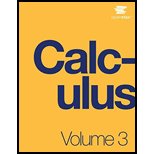
Concept explainers
Solve the boundary-value problem, if possible.
44.
Want to see the full answer?
Check out a sample textbook solution
Chapter 7 Solutions
Calculus Volume 3
Additional Math Textbook Solutions
Calculus: Early Transcendentals (2nd Edition)
Elementary Statistics: Picturing the World (7th Edition)
A Problem Solving Approach To Mathematics For Elementary School Teachers (13th Edition)
A First Course in Probability (10th Edition)
University Calculus: Early Transcendentals (4th Edition)
- PLease solve handwritten, dont use AI.arrow_forwardplease solve the question handwritten without AIarrow_forwardCan you explain this statement below in layman's terms? Secondary Analysis with Generalized Linear Mixed Model with clustering for Hospital Center and ICUvs Ward EnrolmentIn a secondary adjusted analysis we used generalized linear mixed models with random effects forcenter (a stratification variable in the primary analyses). In this analysis, the relative risk for the primaryoutcome of 90-day mortality for 7 versus 14 days of antibiotics was 0.90 (95% Confidence Interval [CI]0.78, 1.05).arrow_forward
- 2 Solve for (x, y, z) in the set of linear, inhomogeneous equations: 2x+5y + z = 2 x+y+2x=1 2+52=3.arrow_forwardProve by induction that for any natural number N, 1 N Σ42 = 6 N(N + 1)(2N + 1). k=1 Indicate clearly where you use the inductive hypothesis.arrow_forward2x-y=1 x+2y=7 y = 2x + 2 3x + 2y = 4 x+3y=0 x-3y=6 8 4x-2y=7 x + 3y = 7 10 2x-2y=5 2x + 3y+ 1 = 0 Ke int lin Chapter 14arrow_forward
- (a) (b) Let A, B be disjoint subsets of a set X. Show that AC Bc. Use proof by contradiction to show that for any a, b = R, if a is rational and b is irrational then ba is irrational.arrow_forward(d) Consider the sequences (xn), (yn) defined recursively as follows: Xn+1 = xn2yn, i. ii. n, Yn+1=Yn2xn for n ≥ 1, x1 = 1, y₁ = 2. Calculate x2, y2 and x3, Y3. - Show using induction or otherwise that for any natural number - Xn+Yni = (1+2i)". Hence or otherwise, show that for any natural number n, iii. Zn = (V5)” cos(n arctan2), n = (V5)” sin(n arctan 2).arrow_forward2. (a) For each of the following functions, decide whether it is injective, and whether it is surjective. Justify your answers. i. f: Z → 22 Z 3z +1 ii. 9: C→ 22 Re(z) + Im(z)arrow_forward
- Not use ai pleasearrow_forward2. Given f(0) = (2 cos 0)² - 3sin²0. 1 a. Show that f(0) = ½ + ½ 7 + - cos cos 20. 2 2 b. Hence, find the exact value of √² 0 ƒ (0) do.arrow_forward2. Given f(0) = (2 cos 0)² - 3sin²0. 1 a. Show that f(0) = ½ + ½ 7 +-cos cos 20. 2 2 b. Hence, find the exact value of √ ƒ (0) d0.arrow_forward
 Discrete Mathematics and Its Applications ( 8th I...MathISBN:9781259676512Author:Kenneth H RosenPublisher:McGraw-Hill Education
Discrete Mathematics and Its Applications ( 8th I...MathISBN:9781259676512Author:Kenneth H RosenPublisher:McGraw-Hill Education Mathematics for Elementary Teachers with Activiti...MathISBN:9780134392790Author:Beckmann, SybillaPublisher:PEARSON
Mathematics for Elementary Teachers with Activiti...MathISBN:9780134392790Author:Beckmann, SybillaPublisher:PEARSON
 Thinking Mathematically (7th Edition)MathISBN:9780134683713Author:Robert F. BlitzerPublisher:PEARSON
Thinking Mathematically (7th Edition)MathISBN:9780134683713Author:Robert F. BlitzerPublisher:PEARSON Discrete Mathematics With ApplicationsMathISBN:9781337694193Author:EPP, Susanna S.Publisher:Cengage Learning,
Discrete Mathematics With ApplicationsMathISBN:9781337694193Author:EPP, Susanna S.Publisher:Cengage Learning, Pathways To Math Literacy (looseleaf)MathISBN:9781259985607Author:David Sobecki Professor, Brian A. MercerPublisher:McGraw-Hill Education
Pathways To Math Literacy (looseleaf)MathISBN:9781259985607Author:David Sobecki Professor, Brian A. MercerPublisher:McGraw-Hill Education





